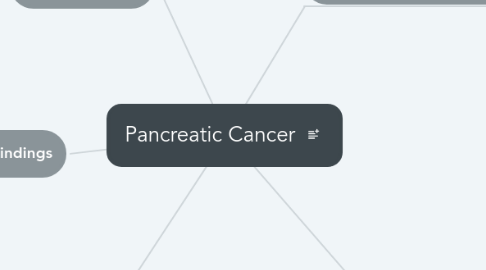Pancreatic Cancer
DanielSam Aciertoにより

1. Diagnostic tests
1.1. Please see algorithm picture upload as a subscription account is required in order to add pictures from upload.
2. Common Findings
2.1. DDx are typically jaundice (from biliary obstruction), epigastric pain (typically more than three days but less than many months), and involuntary weight loss. Most common findings and the percentage of patients that may have them include: Asthenia - 86%, Weight loss - 85%, Anorexia - 83%, Abdominal pain - 79%, Epigastric pain - 71%, Dark urine - 59%, Jaundice - 56%, Nausea - 51%, Back pain - 49%, Diarrhea - 44%, Vomiting - 33%, Steatorrhea - 25%, Thrombophlebitis - 3%.
3. Try MeisterTask!
4. Prognosis & Treatments
4.1. Unfortunately prognosis of pancreatic cancer is poor prognosis, with five year surgical pancreaticoduodenectomy survival rate (with at least one affected node) noted as 10%, and with no nodes affected are 30%. Surgical resection of the pancreas (and potentially the surrounding organs) is considered the only treatment, but as this cancer is typically found so late and has such a bad prognosis, only 15-20% of patients are potential candidates (Fernandez-del Castillo & Jimenez, 2017).
5. Pathophysiologic etiology
5.1. Most often referring to ductal adenocarcinoma, composing roughly 85% of all pancreatic neoplasms or growths. Most of these carcinomas “are gritty, hard, gray-white masses that are poorly circumscribed due to invasion of the adjacent pancreas or nearby tissues” (Longnecker, 2017).
5.2. They occur in the head of the pancreas three times more than the body or tail. Enlargening neoplasms may obstruct the pancreatic duct, leading to chronic pancreatitis, since the various pancreatic enzymes may also cause inflammation to the surrounding pancreatic tissue.
5.3. Steatorrhea and malabsorption may not be observed due to the accessory duct of Santorini, which can allow bypass around the pancreatic duct (Longnecker, 2017).
6. Risk factors and Causative factors
6.1. Factors mostly associated with pancreatic cancer include smokeless tobacco and tobacco smoking.
6.2. Alcoholic beverages, Thorium-232 exposure and its decay products, X-radiation, gamma-radiation, radioiodines (including I-131) have limited evidence to cause pancreatic cancer (McCance & Huether, 2014).


